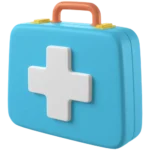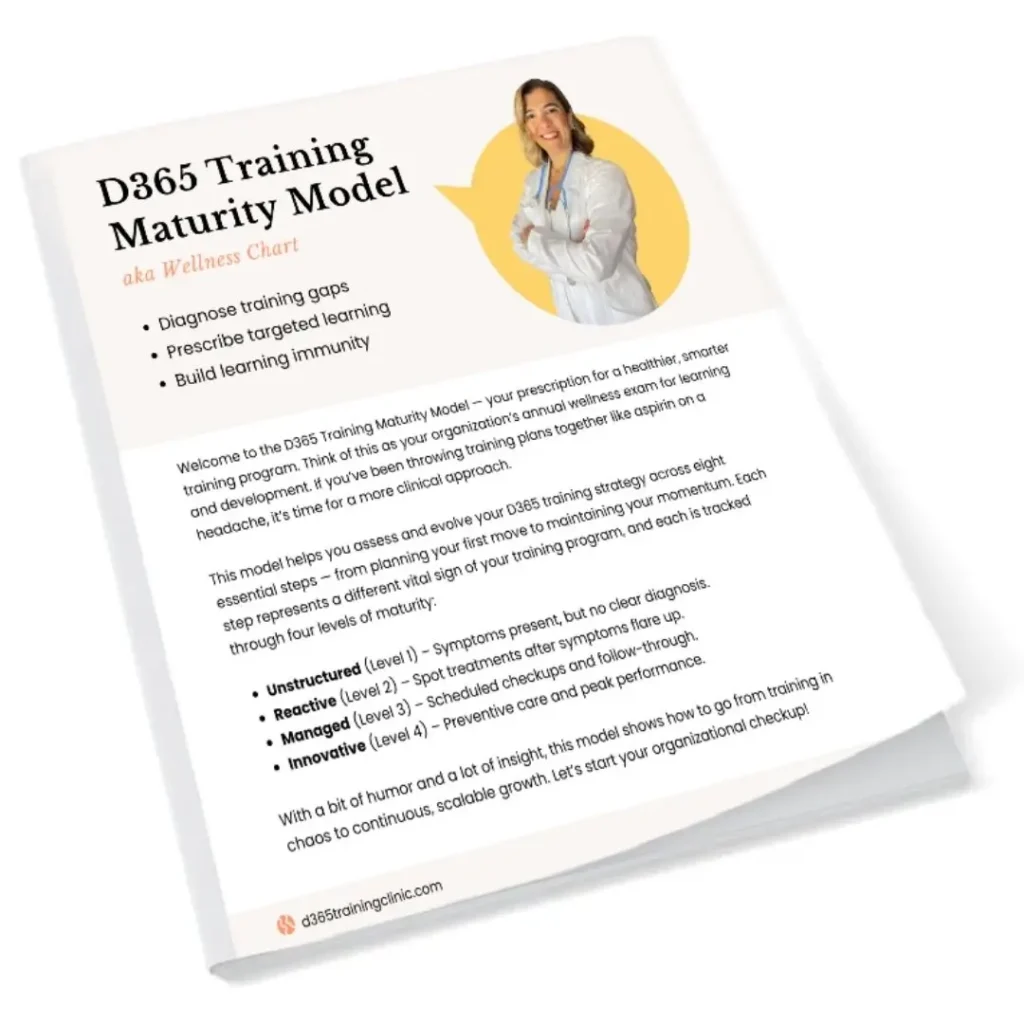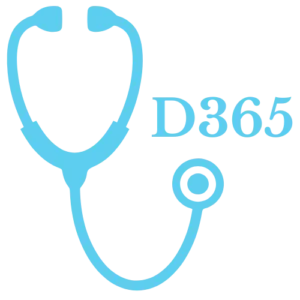D365 Training Maturity Model
aka Wellness Chart
Is your D365 training stuck in the ER — rushed, reactive, and barely breathing? This model walks it to rehab, builds muscle, and sets it up for a full recovery.

Table of Content

Get Free eBook
Join the clinic rounds — we’ll send you expert-approved remedies straight to your inbox.
D365 Training Maturity Model
aka Wellness Chart
- Unstructured(Level 1) – Symptoms present, but no clear diagnosis.
- Reactive(Level 2) – Spot treatments after symptoms flare up.
- Managed(Level 3) – Scheduled checkups and follow-through.
- Innovative(Level 4) – Preventive care and peak performance.
🩺 Step 1: Plan
This is where you decide whether your training strategy is a scribbled prescription or a full patient care plan. The maturity levels here reflect how intentional and sustainable your training design is.|
Level |
Diagnosis |
Description |
|---|---|---|
|
Level 1 – Unstructured |
No Plan |
You’re winging it. Training happens when someone screams loud enough — usually after a failed go-live. No documentation, no calendar, no goals. All crisis, no strategy. |
|
Level 2 – Reactive |
One-Time Training |
You’ve scheduled a training — hooray! But it’s a one-and-done session. Once users attend, they’re expected to retain everything forever. Like a flu shot expected to last forever. |
|
Level 3 – Managed |
Periodic Training |
Training happens on a cadence — maybe quarterly or aligned with releases. There’s planning, budgeting, and iteration. Checkups are scheduled, even if they slip. |
|
Level 4 – Innovative |
Continuous Training |
Training is a living system. New employees get structured onboarding; veterans get upskilling. Training is treated like wellness — always proactive and evolving. |
🔬 Step 2: Develop
This stage measures whether your learning materials are actually suited to your organization — or just generic templates slapped onto specific needs.|
Level |
Diagnosis |
Description |
|---|---|---|
|
Level 1 – Unstructured |
No Content |
There’s no official training content. Maybe a dusty user manual and some internal tribal knowledge. Users are Googling and praying — like self-prescribing herbs for a broken leg. |
|
Level 2 – Reactive |
Standard Content |
You’re using Microsoft Learn or another off-the-shelf solution. It’s helpful but not tailored. Users must bridge gaps between training and real business processes. |
|
Level 3 – Managed |
Standard + Custom (Separate) |
You’ve developed internal content — SOPs, walkthroughs, videos — but they’re siloed from standard materials. Like two pharmacies that don’t share patient records. |
|
Level 4 – Innovative |
Unified, Custom-Enabled Platform |
All training lives in one place. It’s branded, embedded in workflows, and tailored. Delivery feels like precision medicine — effective, seamless, and user-friendly. |
🧬 Step 3: Deliver
This stage looks at how you actually deliver the medicine — or in this case, the training. Is it a home visit or do users have to line up at an inconvenient clinic?|
Level |
Diagnosis |
Description |
|---|---|---|
|
Level 1 – Unstructured |
Manual and Ad Hoc |
Everything is emailed, spreadsheeted, or spread by word of mouth. No learning platform, just DIY chaos — the healthcare equivalent of back-alley diagnostics. |
|
Level 2 – Reactive |
Scheduled (Fixed Time/Location) |
Training is on the calendar, often via Zoom or in-person. It’s rigid — if you miss it, you miss it. Like scheduling a checkup with no reschedule policy. |
|
Level 3 – Managed |
On-Demand |
Training is available when needed: videos, modules, searchable content. It’s like telemedicine — convenient, fast, and accessible. |
|
Level 4 – Innovative |
Self-Paced, Anytime, Anywhere |
The platform is smart, mobile, and personalized. Learning happens in the flow of work — like carrying your own pocket doctor, minus the co-pay. |
🧠 Step 4: Train
This stage focuses on the dosage. Are you giving your learners digestible treatments or dumping the whole pharmacy on them at once?|
Level |
Diagnosis |
Description |
|---|---|---|
|
Level 1 – Unstructured |
Long, Generic, No Practice |
Trainings are long lectures with minimal relevance. Everyone gets the same pill — even if their symptoms are different. It’s inefficient and exhausting. |
|
Level 2 – Reactive |
Short, Generic, No Practice |
Sessions are shorter, but still generic. Like handing out aspirin without checking for migraines or muscle pain. Better than nothing, but far from ideal. |
|
Level 3 – Managed |
Short, Skill-Based, No Practice |
Lessons are now digestible and role-focused. Each has a goal, but lacks interactivity — learners know what to do, but not how to do it confidently. |
|
Level 4 – Innovative |
Short, Skill-Based, Hands-On |
Bite-sized and action-oriented, with real exercises and feedback. Like a clinical rotation — learners build confidence through experience, not just theory. |
🧭 Step 5: Guide
This step is about giving your learners a map — not just dropping them in the forest with a compass. A well-structured path means users always know what’s next.|
Level |
Diagnosis |
Description |
|---|---|---|
|
Level 1 – Unstructured |
No Path |
Learners wander aimlessly with scattered docs and no guidance. Like being lost in a hospital with no signage — lots of hallways, no direction. |
|
Level 2 – Reactive |
One-Size-Fits-All |
Everyone takes the same training, regardless of their role. Like prescribing the same pill for headaches and heartburn — results are hit or miss. |
|
Level 3 – Managed |
Modular & Role-Based |
Training is structured into modules that match user roles. Finance learns finance. Ops learns ops. You’ve finally got a map with “You Are Here.” |
|
Level 4 – Innovative |
Adaptive & Personalized |
Learning adapts based on behavior, progress, and role. You’ve got a smart GPS guiding your training journey — always recalculating and adjusting. |
🧪 Step 6: Measure
Let’s be honest: if you’re not checking vitals, how do you know your patient is healing? This step ensures you have ways to evaluate progress — not just hope for the best.|
Level |
Diagnosis |
Description |
|---|---|---|
|
Level 1 – Unstructured |
No Tests |
Training ends and… that’s it. No quizzes, no reviews. No idea if anyone learned anything. It’s like treating in the dark without even checking vitals. |
|
Level 2 – Reactive |
Basic Quizzes |
There are quizzes, but they’re generic and offer minimal feedback. Like checking your pulse and calling it a full physical exam. |
|
Level 3 – Managed |
Role-Relevant Assessments |
Assessments are tailored to roles and provide feedback. Learners know what they missed and how to improve — like getting a report with doctor’s notes. |
|
Level 4 – Innovative |
Gamified, Diagnostic Assessments |
Fun, adaptive, and actionable. Learners get next steps and managers see readiness. It’s like wearing a Fitbit for your brain — and it even sends alerts. |
📊 Step 7: Track
Training without tracking is like a checkup with no chart. This step ensures you can monitor who’s learning what — and where to intervene.|
Level |
Diagnosis |
Description |
|---|---|---|
|
Level 1 – Unstructured |
No Visibility |
You have no idea who’s been trained. It’s like prescribing meds but forgetting who took what — fingers crossed and no chart in sight. |
|
Level 2 – Reactive |
Individual Logs |
Some logs exist, usually in spreadsheets, but no big-picture insight. You’re flipping through patient records one page at a time. |
|
Level 3 – Managed |
Team Dashboards |
Managers can see who’s completed what, and the data starts to make sense. The clinic now has computers — and they work. |
|
Level 4 – Innovative |
Organization-Wide Insights |
Performance trends, red flags, and adoption gaps are visible at a glance. You’ve moved from triage to population-level care. |
🩹 Step 8: Maintain
Training doesn’t end at go-live. You need support that sticks around — like follow-up visits and wellness plans.|
Level |
Diagnosis |
Description |
|---|---|---|
|
Level 1 – Unstructured |
No Support |
Once training ends, learners are left in the dark. No help, no updates — just echoes in a ghost town of forgotten post-care. |
|
Level 2 – Reactive |
Fix-It-When-Broken |
Support only kicks in when complaints roll in. You’re stuck in a constant cycle of emergency triage and damage control. |
|
Level 3 – Managed |
Regular Updates & Help |
Support is expected and consistent. Learners know where to turn, and updates arrive like flu shots — timely and preventive. |
|
Level 4 – Innovative |
Proactive, Personalized Support |
Contextual help, embedded guidance, and real-time nudges. Support evolves with the platform — like a wellness coach who lives in your app. |
🩺 Ready to run your own diagnostics?
Use the chart below to self-assess, prescribe the right interventions, and begin building a training program that actually heals.
|
Maturity Stage
|
Level 1
|
Level 2
|
Level 3
|
Level 4
|
|
Unstructured
|
Reactive
|
Managed
|
Innovative
|
|
|
Plan
|
No Plan
|
One Time
Training
|
Periodic
Training
|
Continuous
Training
|
|
Develop
|
No Content
|
Standard Content
|
Standard + Custom (Separate)
|
Unified Custom-Enabled Platform
|
|
Deliver
|
Manual and Add hoc
|
Scheduled (Fixed time and Location)
|
On-Demand
|
Self-Paced, Any time, Any where
|
|
Train
|
Long, Generic, No Practice
|
Short, Generic, No Practice
|
Short, Skill-based, No practice
|
Short, Skill-based, Hands-on
|
|
Guide
|
No Path
|
One-Size-Fits-All
|
Moduler & Role-Based
|
Adaptive & Personalized
|
|
Measure
|
No Assessments
|
Basic Quizzes
|
Role-Relevant Assessments
|
Gamified, Diagnostic Assessments
|
|
Track
|
No Visibility
|
Individual Logs
|
Team Dashboards
|
Organization-Wide Insights
|
|
Maintain
|
No Support
|
Fix-It-When-Broken
|
Regular Updates & Help
|
Proactive, Personalized Support
|
